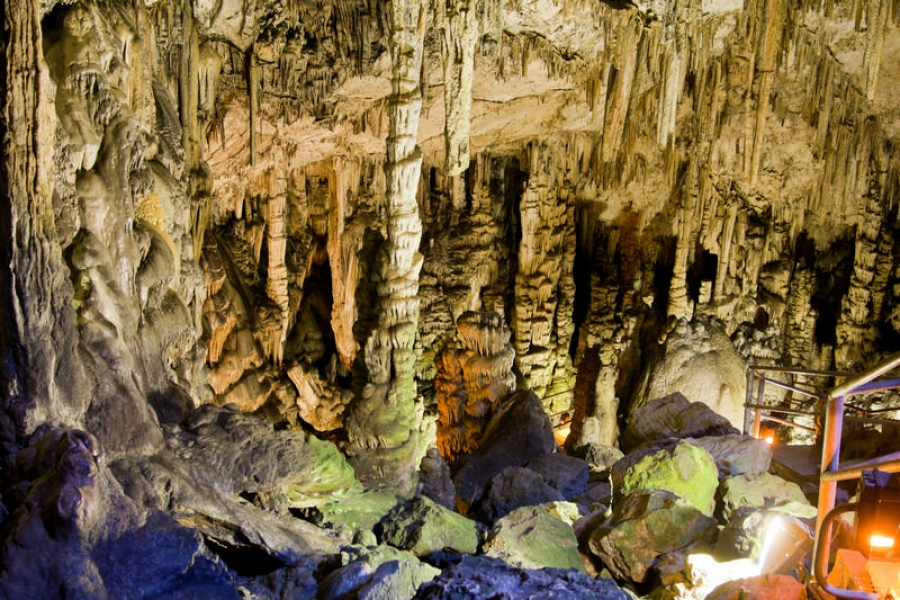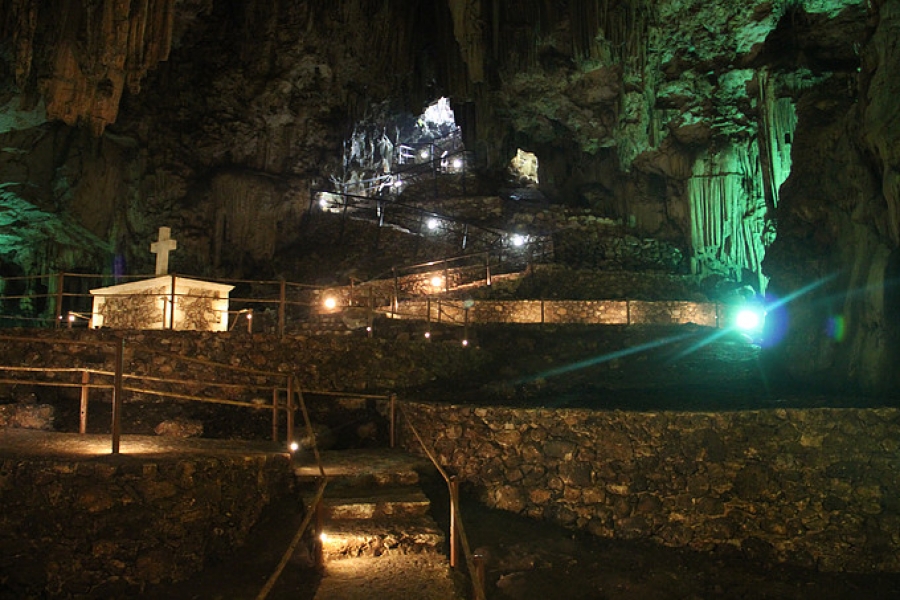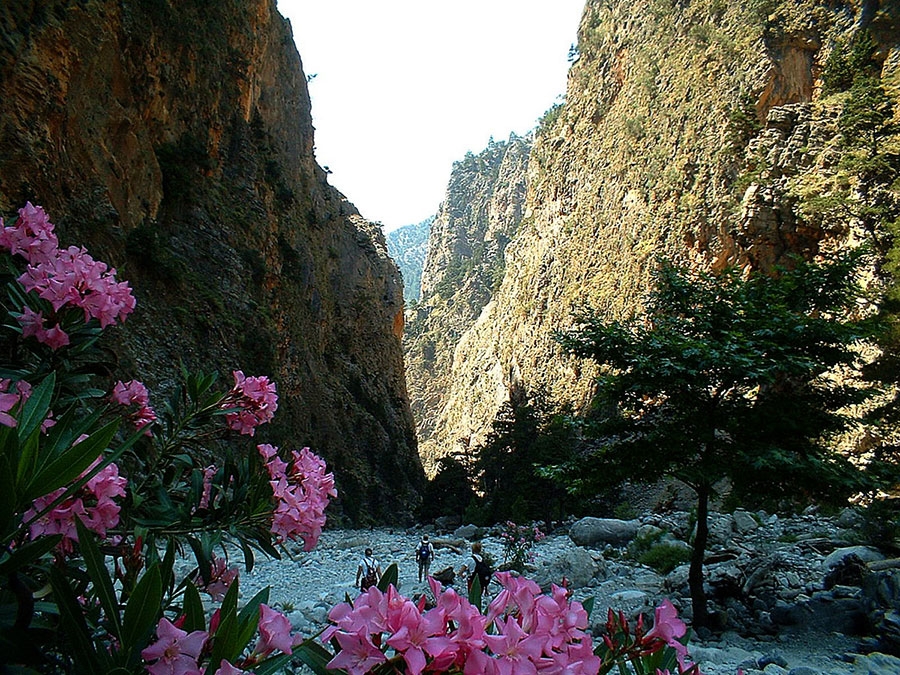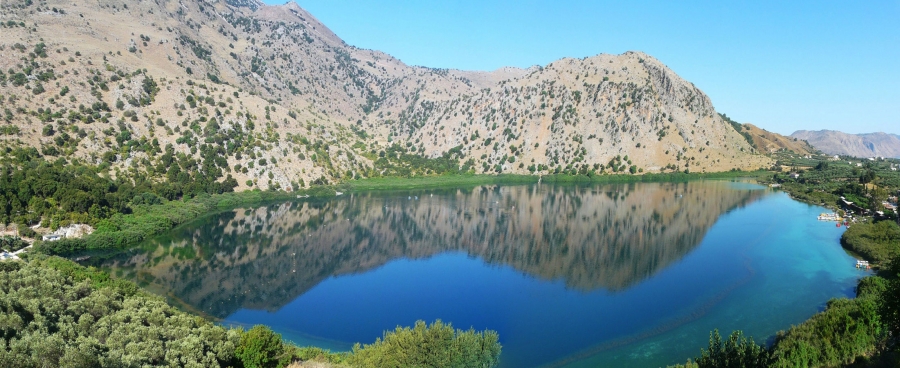Exclusive Private Services: Excursions, Shore Trips, Daily Tours & Transfers Contact Us
On the northern slopes of Mt. Dicte and the southeastern slopes of Mountain Sarakinos, at a height of 1,025 m, lies the Psychro Cave, also known as Diktaion Antron, an ancient site of worship and one of Crete’s most important and impressive Caves.
There are two paved paths leading up to the cave, starting from the parking area and passing through a dense forest that creates a green zone in this wild and rocky landscape. The discovery of the cave by villagers in 1883 attracted some of the era’s well-known archaeologists. Thus three years later, Federico Halbherr and Joseph Chatzidakis arrived and excavated a small area in front of its inlet, while at the same time gathering objects found by villagers.
In 1894, Arthur Evans purchased objects that had come from the cave; in 1895 he revisited the site and discovered part of an inscribed offering table, while in 1896 he carried out a small-scale excavation. The most interesting piece among the objects he gathered is a bronze sheet believed to depict all the elements of cosmogony. In 1897, the French archaeologist Joseph Demargne uncovered another piece of the offering table discovered by Evans as well as a gold diadem, of which up to now only its description is known. The most systematic research program held in 1899 by D.G. Hogarth brought to light finds dating from the Middle Minoan to the Archaic period (ca.1800-7th c. BC) – with the exception of a few sporadic down to the Medieval period objects – and proved Psychro Cave to be one of Crete’s most important sites of worship. The excavation started from the so-called Upper Cave, which rather resembles a rock-shelter and has no stalactites. It is 35 m wide and about 16 m in depth, and consists of two chambers, of which the first is completely open and well-lit. Here the sacred temenos, formed by an irregular enclosure and paved in places, was discovered. Within the enclosure, a rectangular rubble altar was identified and according to the excavator was older than the temenos itself.
Later on the Lower Cave was explored. It consists of five smaller or larger chambers with a small lake at its end, and has large, impressive columns of stalactites and stalagmites which in antiquity became objects of worship for pilgrims. Most of the bronze male and female figurines, bronze tools, knives, axes, razors, blades, seals and fibulae, all of which were votives offered by pilgrims who came even from distant lands to render honors to the deity, were found here. From the beginning of its excavation the Psychro Cave was associated with ancient tradition’s Diktaion Antron, where Rhea fled to escape Kronos (who devoured his offspring) and where she gave birth to Zeus, father of gods and mortals. The newborn god was nourished by Amaltheia, who was either a goat or, according to other ancient writers, a Nymph. To shelter the infant’s cries from Kronos, the Kouretes made noise by banging their weapons and dancing. According to other mythical traditions, the god was nurtured by bees, or doves, or a sow. Lucian tells us that after abducting Europa from Phoenicia, Zeus brought her to the Diktaion Antron. The ancient seer Epimenides was also said to have “slept” in the cave for many years and visualized some of his prophecies.
Today, Psychro Cave is also an interesting natural habitat, as it has been noted that various species of bats, among them the Mediterranean long-eared bat, nest in the chambers of the Lower Cave. There are also cave-dwelling arthropods, while numerous bird species find refuge in its entrance, just as they do in the Upper Cave.
The Melidoni Cave is located about 1800 metres northwest of a village with the same name. It has an extremely interesting history and amazing archaeological findings some of which are exhibited in the Archaeological Museum of Rethymno.
The Melidoni Cave is also called "Gerondospilios". It was used for religious ceremonies. During the Minoan Civilization, it was a place of worship for Talos the bronze giant guardian of Crete who protected the island of Crete from enemies.
It is of archaeological and historical interest. In October 1823, 370 women and children and 30 warriors who hid from Hussein Bey sought refuge in the Melidoni cave. When he found out, the cave was surrounded by his army and he asked Cretan people to surrender. When they refused to do so, Ottomans started to attack them. Three months later they dropped combustible materials into an opening leading to the cave and set it on fire. Men, women and children lost their lives in the cave in January 1824. In the central room of the cave there is an ossuary containing the bones of the heroes of Melidoni cave.
The arched entrance to the cave is leading to the first chamber of the cave called "Room of Heroes", where we see "Mnemion" (Monument), a complex filled with stalagmites. On the way to "Stavrodromi" (Crossroad) we get into the right chamber. We reach the "Pashley Room" where stalagmites and stalactites create a wonderful complex. As we keep on walking, the rock formations give the impression of being on another planet. In the "Room of the rocks" through a narrow path we reach the "Chamber of Katavothra" and we turn right to the "Iperoon" (Gallery). Walking down the cave we reach "Stavrodromi" again and we walk on the left side of the cave which has only one chamber "The Chamber of Curtains", which is adorned with impressive stalactites and stalagmites.
Earlier archaeological findings. In 1940 a double axe was handed over the Heraklion Museum, probably found during illegal excavations, while Neolithic tools were found in 1928. In 1954 P. Faure was able to gather in a more systematic way detailed archaeological information, when he conducted a limited research in the cave, during which he discovered Late Minoan, Geometric as well as Roman pottery.
During the Roman period the cave was used as a sanctuary of “Taleos Hermes” and sacrifices were performed here to honor him. The cave was actually a significant sacred site in the region, as it was situated on the “crossroad” of three great ancient cities: Axos, Eleftherna and Grivilon.
The Samaria Gorge is a National Park of Greece on the island of Crete - a major tourist attraction of the island - and a World's Biosphere Reserve.
The gorge is in southwest Crete in the regional unit of Chania. It was created by a small river running between the White Mountains (Lefka Ori) and Mt. Volakias. There are a number of other gorges in the White Mountains.
While some say that the gorge is 18 km long, this distance refers to the distance between the settlement of Omalos on the northern side of the plateau and the village of Agia Roumeli. In fact, the gorge is 16 km long, starting at an altitude of 1,250 m at the northern entrance, and ending at the shores of the Libyan Sea in Agia Roumeli.
The walk through Samaria National Park is 13 km long, but one has to walk another three kilometers to Agia Roumeli from the park exit, making the hike 16 km long. The most famous part of the gorge is the stretch known as the Gates (or, albeit incorrectly, as "Iron Gates"), where the sides of the gorge close in to a width of only four meters and soar up to a height of almost 300 meters (1,000 feet).
The gorge became a national park in 1962, particularly as a refuge for the rare kri-kri (Cretan goat), which is largely restricted to the park and an island just off the shore of Agia Marina.
There are several other endemic species in the gorge and surrounding area, as well as many other species of flowers and birds.
The village of Samaria lies just inside the gorge. It was finally abandoned by the last remaining inhabitants in 1962 to make way for the park. The village and the gorge take their names from the village's ancient church, Ossia Maria.
A must for visitors to Crete is to complete the walk down the gorge from the Omalos plateau to Agia Roumeli on the Libyan Sea, at which point tourists sail to the nearby village of Hora Sfakion where their chauffer will be waiting for them.
The walk takes six to eight hours and can be strenuous, especially at the peak of summer.
Kournas lake is the largest natural lake in Crete.
It is fed by the waters coming down from the mountains, and from two sources located in the southeastern part of the lake, while drained, through the river of Delfinas, on the beach of Kournas which is 2,5 km further north.
The abundant water throughout the year, makes the lake an important wetland area with a variety of flora and fauna, and so it is included in the Natura 2000 protection program.
Kournas lake is surrounded by hills, just a few kilometres away from the sea and at the boundaries of Chania and Rethymno. The lake was known as Korisia in antiquity and is nowadays a destination attracting thousands of visitors every year. The lake’s water increases during winter, from adjacent sources in the mountains and decreases in summer revealing a gold sandy strip. The shallow clear waters at the shore gradually get darker towards the centre of the lake, reaching a maximum depth of 22.5m. Gaze at its surface mirroring the green surrounding, a safe haven to the area’s avifauna and protected by the Natura 2000 program.
Home to a large number of birds and animals, Lake Kournas is the place where you can encounter moorhens, ducks, geese, herons, cormorants, eels, water snakes, goldfish and rare species of turtles who are permanent residents of this friendly wetland.
Seize the moment by:
- hopping on a pedal boat and enjoying a ride followed by ducks
- relaxing on a lounger and letting your eyes capture the unspeakable beauty of the landscape that changes colours as the sun tilts
- walking along the lake shore and taking in the peace and tranquility.
If the previous activities have opened your appetite you may want to taste some traditional Cretan recipes in tavernas located nearby, on the main road.






